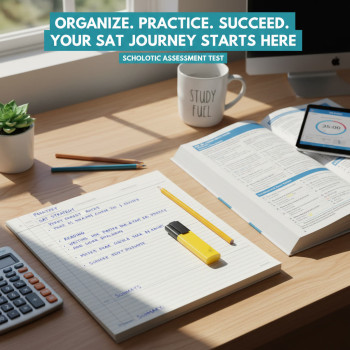The SAT Student Lifestyle: Balancing Life and Prep
Let’s be honest: prepping for the Digital SAT can feel like adding a second job to an already full plate. Between classes, clubs, family, jobs, and the (very real) need to do things that keep you human — friends, hobbies, sleep — the temptation is to either panic and binge-study for a weekend or freeze and put off prep altogether. Neither helps.
Why balance matters (beyond the score)
The SAT measures certain academic skills, but the way you get there affects performance as much as raw knowledge. Cramming can boost short-term recall but damages long-term confidence and mental stamina. Burnout makes even simple reading passages feel like obstacles. A balanced approach keeps your brain sharp, your motivation steady, and your test-day nerves manageable — all of which translate into better performance.
Start with a student-first framework
Before building a schedule or opening another practice test, take a breath and ask three simple questions:
- What does my week actually look like? (Be honest — include commute, chores, social time.)
- What are my strengths and the 2–3 weaknesses that cost me points? (Focus matters more than more practice.)
- How many weeks do I have until my target test date and what’s realistic to commit now?
Answering these will save you time. For example, a student who’s strong in math but loses points on command-of-evidence questions in Reading & Writing should prioritize targeted practice on that skill rather than 20 full-length tests.
Set humane, high-impact goals
Goals should be specific, measurable, and kind. “Get 1500” is vague because it doesn’t say what you’ll change. “Improve Evidence-Based Reading & Writing by 80–100 points in 8 weeks by doing targeted passage practice three times a week” is actionable and motivating.
Design a realistic weekly plan
Instead of thinking in marathon sessions, design a weekly rhythm that respects attention and recovery.
- Short daily practice (30–45 minutes) 4–6 days a week beats a single 5-hour session once a week.
- One in-depth session (90–120 minutes) on the weekend to simulate sustained focus and practice timing under calmer conditions.
- At least one full practice test every 2–3 weeks as you approach your test date to build stamina and refine pacing.
Example weekly schedule (for a busy high school student)
| Time | Monday | Tuesday | Wednesday | Thursday | Friday | Saturday | Sunday |
|---|---|---|---|---|---|---|---|
| Before school | 10–15 min vocab/passage warm-up | 10–15 min math review (formulas) | 10–15 min reading warm-up | 10–15 min grammar tips | 10–15 min math drills | 90–120 min practice test / review | Rest + 30–45 min targeted review |
| After school | Homework + 30–45 min targeted practice | Clubs / homework + 30–45 min targeted practice | Sports / homework + 30–45 min targeted practice | Homework + 30–45 min mixed practice | Light review / social time |
This schedule respects school commitments and keeps practice frequent but manageable. Swap slots to fit your life: the best plan is the one you can stick to.
Make practice work for you — not the other way around
Practice without strategy is busywork. Turn each session into a deliberate experiment. Here’s how.
1. Start with diagnostics
Take one full, timed practice test at the beginning (and one every few weeks). Use the results to identify patterns: running out of time, careless arithmetic errors, trouble with graphs, or misreading questions. These patterns tell you where to spend energy.
2. Use micro-goals and mixed practice
- Micro-goal: “Today I’ll get 8/10 function-graph questions correct.”
- Mixed practice: 20 minutes of evidence-based reading questions, 20 minutes of algebra, 10 minutes of grammar rules. Mixing helps you switch mental gears like you’ll need to on test day.
3. Review like a scientist
When you miss a question, don’t just mark it and move on. Journal the error: what was the trap, why did you pick the wrong answer, and what’s a fast strategy to avoid it again? Over weeks you’ll see the same patterns, and that repeated small correction is what builds score gains.
Practical time-saving tactics
Students always ask how to squeeze more out of limited hours. Try these tactics:
- Use commuting time for passive review: flashcards, vocabulary, or reading short passages on your phone.
- Create a 10-minute “error catalog” you build after each session; reviewing it once a week keeps mistakes from repeating.
- Practice questions with a stopwatch to train pacing for each question type (e.g., 1.2 minutes per grid-in math item or 13 minutes per reading passage, adjusted to your pacing needs).
Balance your mental and physical health
Top scores aren’t generated by sleepless nights. They come from rested brains, good habits, and confidence.
Sleep and recovery
Sleep consolidates memory. Aim for 7–9 hours when you’re studying intensively. If a late-night cram looks tempting, ask: will those extra two hours of sleep help me more than those extra two hours of study? Often, the answer is yes.
Nutrition and movement
Fueling your brain matters. Small changes — a protein-rich breakfast before practice, a short walk after a long study block, staying hydrated — produce noticeable improvements in focus and mood.
Mental health and perspective
College admissions are important, but they are not everything. Schedule non-negotiable social or creative time each week. These breaks recharge motivation and prevent the “SAT tunnel” where nothing else feels real.
Group study, tutoring, and personalization
There’s power in community, but not all group study is equal. Effective group sessions have structure: a focused goal, rotation of roles (reader, timekeeper, explainer), and a post-session reflection on what worked.
When to choose 1-on-1 tutoring
If your progress has plateaued or you need accountability and tailored strategies, 1-on-1 tutoring can be a game-changer. Personal tutors identify blind spots faster and create targeted study plans that respect your schedule and learning style. For example, Sparkl’s personalized tutoring offers one-on-one guidance, tailored study plans, expert tutors, and AI-driven insights that can help you focus practice where it matters most — without wasting hours on low-yield tasks.
Smart use of practice tests
Full-length practice tests are essential, but they’re only as useful as your follow-up. Here’s how to get maximum value:
- Simulate test conditions: same start time, minimal breaks, and using the same digital tools you’ll use on test day.
- Score and analyze immediately: identify timing drops, repeating traps, and sections that consistently cost you points.
- Targeted remediation: after a practice test, spend 2–3 sessions fixing the three most common mistakes you saw.
Practice-test rhythm as you approach test day
Eight weeks out: one full test every 10–14 days. Four weeks out: one every 7–10 days. Final two weeks: taper intensity; do one simulated test 6–7 days before test day, then one light practice session 2–3 days before to keep skills active without fatiguing yourself.
Test-day strategies that fit a balanced lifestyle
Test day is the intersection of preparation and poise. Here are practical routines that help you perform as your best self.
Night before
- Finish reviewing high-yield notes or flashcards — avoid learning new strategies.
- Lay out everything you need: admission materials, device setup (for Digital SAT), snacks allowed by the testing rules, and a comfortable outfit.
- Do a calming 10–15 minute routine — breathing, a short walk, or light reading — then go to bed at a sensible hour.
Morning of
- Have a familiar, balanced breakfast — nothing experimental.
- Arrive early to the test center or have your device setup complete so you’re not rushed.
- Use the first 2–3 minutes to breathe and set a simple intention: steady pace, read carefully, and trust your prepared strategies.
During the test
- Handle tricky questions strategically: mark and move on when stuck, come back if time allows.
- Use short resets between sections: drink water, stand for 30 seconds, and refocus.
- Watch your pace but don’t panic — consistent accuracy beats frantic guessing.
Real-world examples — how three students balanced life and prep
Concrete examples help make strategy real. Here are short profiles (composite and anonymized) showing different approaches.
Maya — the AP-stacked senior
Maya had two AP classes, a part-time job, and wanted to apply early. Her challenge: no large blocks of free time. Her solution was micro-practice: 30 minutes a day, focusing on weak question types. She used Sundays for one longer practice test and weekly 1-on-1 sessions with a tutor who helped her prioritize content. Over 10 weeks she made steady gains without sacrificing sleep or work hours.
Jordan — the athlete
Jordan practiced after afternoon training, so energy was low. He shifted heavier cognitive work to mornings and used recovery days to do light, confidence-building practice. He found that a single practice test every two weeks plus targeted math drills kept him improving while preserving performance on the field.
Sophia — the student who needed structure
Sophia wanted accountability and a clear plan. She worked with a personalized tutor who created a tailored schedule, tracked her errors, and provided AI-driven insights to adjust focus topics weekly. The structure reduced procrastination and kept her stress in check.
Tools and techniques that actually help
Not all study technology is equal. Prioritize tools that provide feedback and adapt to you:
- Adaptive practice platforms that focus on your weak areas.
- Timer apps that mimic section timing and signal practice sprints.
- Physical or digital error logs to track recurring mistakes and measure progress.
When used well, these tools save time and increase precision. If you work with a tutor or a program like Sparkl, AI-driven insights and tailored study plans can speed progress by focusing your effort where it matters most.
What to do when you feel stuck or discouraged
Slumps happen. The trick is to have small, practical resets:
- Take a 48-hour break from test prep and do something nourishing — music, a hike, or time with friends.
- Switch modalities: if you’ve been doing passive practice, try teaching a concept to a friend — explaining solidifies understanding faster than re-reading notes.
- Revisit your diagnostic: sometimes a plateau signals that the strategy, not your effort, needs changing.
When to register and how to plan around deadlines
Plan registration so you have clear rehearsal periods. Aim to have one well-paced rehearsal cycle (6–10 weeks of steady practice) before your target test date. If life gets busy, it’s better to postpone to the next administration than to show up underprepared. Keep a calendar of deadlines and build back from the test date — that clarity reduces stress and improves focus.
Long game: what matters after test day
After you take the test, treat the weeks that follow as learning, not judgment time. Scores are data: they show what to focus on next. Whether you retake the test or move on to other parts of college prep, use your results to inform next steps, not to define your worth.
If you retake
Analyze weak areas and aim for targeted improvement. Often a relatively small change in strategy or timing yields a noticeable score jump.
If you don’t retake
Focus energy on other parts of your application where you can make gains: essays, extracurriculars, or subject mastery. A balanced life doesn’t end with one test — it sets you up for sustained success.
Final checklist: balance-friendly SAT prep
| Focus Area | Action | Why it helps |
|---|---|---|
| Weekly rhythm | Short daily practice + one longer weekend session | Builds consistency and protects attention |
| Targeted practice | Fix 2–3 recurring mistakes first | High score gain per hour invested |
| Mental health | Schedule social/creative time weekly | Prevents burnout and maintains motivation |
| Simulation | Full practice tests under test conditions | Improves pacing and stamina |
| Personalization | Use a tutor or adaptive plan when stuck | Targets weaknesses faster and saves time |
Parting thought: keep yourself in the equation
It’s tempting to treat the SAT as a tunnel you have to survive. Instead, think of it as one benchmark among many — a challenge you can meet without losing the rest of your life. Real growth happens when you prepare smartly, respect your limits, and protect the parts of yourself that make you resilient: curiosity, rest, and joy. That balanced approach is not just better for your score; it’s better for your life.
If you want structure but dread one-size-fits-all plans, consider a personalized program: a tutor who actually listens, an adaptive plan that targets your unique mistakes, and AI-driven insights to keep sessions efficient. Sparkl’s personalized tutoring model, with one-on-one guidance and tailored study plans, can be a helpful bridge for students who need both flexibility and focused accountability — especially when life is busy.
Balancing life and SAT prep is a practice in priorities, not perfection. Start small, adjust often, and give yourself permission to be both a student and a person. You’ll be surprised how much progress you can make when studying fits into your life — rather than taking it over.
Good luck. You’ve got this.

















No Comments
Leave a comment Cancel